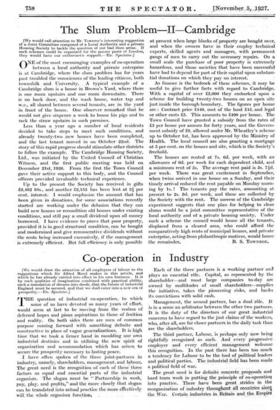The Slum Problem—IT—Cambridge
[We would call attention to Mr. Townroe's interesting suggestion of a Joint Committee composed of a Local Authority and a private Housing Society to tackle the question of our bad shun areas. If such schemes could be organized for the poorer parts of London, they would have our enthusiastic support.—ED. Spectator.] ONE of the most encouraging examples of co-operation between a local authority and private enterprise is at Cambridge, where the slum problem has for years past troubled the consciences of the leading citizens, both townsfolk and University. A typical example of a Cambridge slum is a house in Brown's Yard, where there is one room upstairs and one room downstairs. There is no back door, and the wash house, water tap and w.c., all shared between several tenants, are in the yard in front of the. house. One observer remarked that he would not give sixpence a week to house his pigs and to rack the straw upstairs in such premises. Less than a year ago a number of local residents decided to take steps to meet such conditions, and already twenty-two new houses have been completed, and the last tenant moved in on October 22nd. The story of this rapid progress should stimulate other districts to follow the example. The Cambridge Housing Society, Ltd., was initiated by the United Council of Christian Witness, and the first public meeting was held on December 21st, 1926. From the first the Town Council gave their active support to this body, and the Council officers provided invaluable technical experience.
Up to the present the Society has received in gifts £3,462 10s., and another £2,155 has been lent at 2i per cent. interest. I would emphasize the amount that has been given in donations, for some associations recently started are working under the delusion that they can build new houses or recondition old houses under existing conditions, and still .pay a small dividend upon all money borrowed. I have evidence to prove that poor property, provided it is in good structural condition, can be bought and modernized and give remunerative dividends without the rents being increased excessively, if the management is extremely efficient. But full efficiency is only possible at present _when large blocks of property are bought over, and when the owners have in their employ technical experts, skilled agents and managers, with permanent gangs of men to carry out the necessary repairs. On a small scale the purchase of poor property is extremely hazardous, and those societies that have been successful have had to depend for part of their capital upon substar- tial donations on which they pay no interest. As finance is the bedrock of these schemes, it may be useful to give further facts with regard to Cambridge. With a capital of over £5,000 they embarked upon a scheme for building twenty-two houses on an open site just inside the borough boundary. The figures per house are : Contract price £440, cost of the land £45,-and legal or other costs £5. This amounts to £490 per house. The Town Council have granted a subsidy from the rates of £5 per house per annum for forty years, and the Govern- ment subsidy of £9, allowed under Mr. Wheatley's scheme up to October 1st, has been approved by the Ministry of Health. The local council are also granting a mortgage at 5 per cent. on the houses and site, which is the Society's freehold,.
The houses are rented at 7s. 6d. per week, with an allowance of 6d. per week for each dependent child, and a minimum rent of 5s. The- average rent paid -is 5s. 70. per week. There was great excitement in - September, when twins arrived in one house on a Sunday, and their timely arrival reduced the rent payable on Monday morn- ing by ls. ! The tenants pay the rates, amounting at present to 2s. 3d. per week, and these are collected by the Society with the rent, The success of the Cambridge experiment suggests that one plan for helping to clear slums would be a joint committee representative of .the local authority and of a private housing society. Under such a scheme the council would house all the tenants, displaced from a cleared area, who could afford the comparatively high rents of municipal houses, and private enterprise, acting from philanthropic motives, would house


















































 Previous page
Previous page